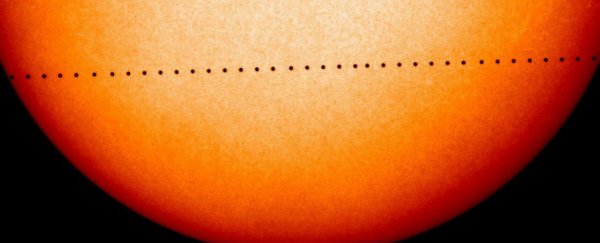On Monday May 9, it's time to drop everything and remind yourself that whatever crap you've got going on, you're still a part of a giant, unknowable Solar System filled with mysterious neighbours like our potential new home, Mars, and whatever the hell Planet Nine actually is. Because for the first time in a decade, we're about to witness Mercury make its rare transit across the enormous face of the Sun.
In an event that only happens 13 times every century, Mercury's orbit will bring it in range of one of the best backdrops of the Universe, and we're not going to see anything like this again until 2019, and after that, not until 2032.
The best part about this particular transit of Mercury is that it will be viewable in most places on Earth, and unlike many cosmic phenomena that are both fleeting and difficult to locate in the sky, you've got a good 7-8 hours to watch this event, and it's not exactly hard to figure out where to look.
As Fiona MacDonald reported for us last month, the transit is expected to begin at around 7am EDT (9pm AEST, 11am UTC), and will last all day. Depending on where you live, this is either super convenient, or in the dead of night:
"The good news is that the entire event will be visible to those on North America's east coast, as well as most of South America, western Europe and the west coast of Africa. And stargazers in western Asia and western North America will also be able to see part of the transit. The bad news is that people in Indonesia, Australasia, and eastern Asia are going to miss the whole thing during our night time."
For the lucky people in the Northern Hemisphere, you've got a number of options for viewing this event.
But firstly, let's all take a moment to remind ourselves that looking at the Sun with a regular backyard telescope is incredibly dangerous for isolated pig's eyes and humans alike.
If you want to view the event through a telescope, you need to fit it with a special solar filter, but be warned: this can get expensive. Having said that, if you want to invest in a solar filter like the budding astronomer you are, Space.com has some good advice about which ones to pursue.
Other options for viewing include calling up your local astronomy group and seeing what equipment they can give you access to, or fashioning your own make-shift 'pinhole projection' device, which you can read about here.
Or, you know, you can sit in your office and watch the NASA Solar Dynamics Observatory's real-time coverage of the event, which all of us down here in Australia will be doing while we're supposed to be asleep.
But it'll be entirely worth it, says Geoff Gaherty for Space.com: "For me, the most exciting thing about observing a transit is more aesthetic than scientific. To see a tiny world silhouetted against the mighty sun gives a striking view of the scale of the Solar System."
Like Gaherty, the value of the transit for most of us is mainly that it's awe-inspiring, and, you know, incredibly cool-looking, but for astronomers, it offers a goldmine of information to study about Mercury's unusual atmosphere.
As the NASA video below explains, the bright backdrop of the Sun against the dark silhouette of Mercury allows scientists to get a unique look at the componets of Mercury's ultra-thin exosphere - the outermost layer of its atmosphere. You won't be able to see it during the transit, but Mercury's atmosphere streaks off it in such a way that it creates a 'tail' trailing behind it, just like a comet. And this is no wimpy tail - it can stretch almost 2 million km long (1.2 million miles).
Watch below for more information about what astronomers are going to be doing on May 9, and make sure you figure out how you're going to see this thing for yourself on Monday.
As Fiona MacDonald pointed out last month: "How often do we get to see a planet roughly 77 million km (48 million miles) away from us pass in front of the star that gives us life, and really have the chance to ponder our place in the Milky Way?"
